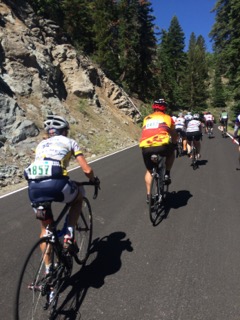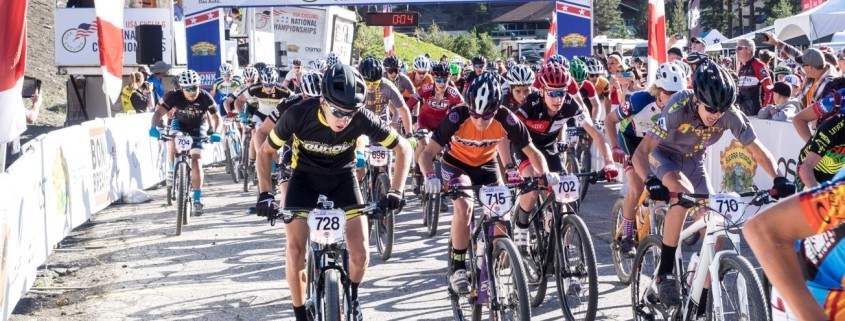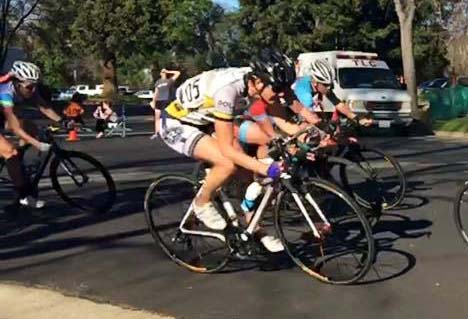Bike fitting: It’s not rocket science, but it is systematic
By Julie Young
Preface: Fitting road, cyclo-cross and mountain bikes follows a similar formula; TT and Triathlon bikes depart from this formula. For this article, we will focus on the road bike.
I enjoy the bike fitting process because it’s not only an opportunity to help educate athletes about the importance of fit in terms of preventing over-use injuries and improving performance, but it’s also a chance to help them understand that with commitment to consistent off-bike mobility and stability work, they’ll continue to improve their fit and power output.
The fit process is more than simply manipulating the parts on the bike; it’s the opportunity to help athletes understand how joint range of motion, muscle length, stability and posture relate to improving the fit and performance. Additionally, it’s also an opportunity to share insights about pedal stroke technique and efficiency.
It seems most of us think we just hop on our bikes and go, with little regard to fit. While cycling is low impact, there is potential for overuse injuries when we consider that we’re locked in a position at the hip and the foot, making a repetitive movement over extended periods of time. And we also want to maximize our ability to use the bike as a tool, meaning we want to be properly placed over the bottom bracket in order to recruit the appropriate muscles around the circular pedal movement.
Bike Fitting is Based on a System
We need to base the fit on a system. Oftentimes clients come in for a fit, and they have cherry-picked the fit system, tried this, tried that, and now find themselves in a state of confusion and discomfort. It goes something like this: “Oh, I read this blog, so I tried moving my seat back. Then I felt stretched, so I lowered the saddle and then moved it forward. And then…”
You get the picture?
But an effective fit is methodical and follows systematic steps.
The Interview
Understanding the individual off the bike is the first priority. The systematically approached bike fit considers what each individual rider brings to the fit in terms of past injuries, muscular length, joint range of motion, how they spend the majority of their day, and their personal cycling goals.
We start our fit at Silver Sage Sports and Fitness Lab with an interview to understand the rider’s goals for riding and motivation for the fit (resolve pain or improve performance), followed by a 20-point physical assessment to understand the individual’s off-bike skeletal structure and movement patterns, as well as flexibility and ranges of motion.
During this off-bike interview, we also want to understand how the athlete spends the majority of his/her day, as this greatly affects the bike fit. For example, if they sit slumped over a computer for eight hours a day, this is likely the posture we will see on the bike. This off-bike investigation allows us to better focus the on-bike fit.
Physical Assessment
During the fit process, we’re helping the athlete understand how different aspects of the off-bike physical assessment relate and connect to the on-bike fit. For example, we measure hamstring length and hip flexion, which helps determine the appropriate saddle-to-bar drop. Some people come in with an idea of how they should look on the bike as a road racer or triathlete. But an aggressively aerodynamic fit can only be effectively achieved if the rider possesses adequate range of motion/muscle length and the ability to hold integrity of neutral pelvis and spinal posture.
That said, the bike fit process is not a one-and-done, but rather an evolution, and through off-bike work of mobility and stability, the fit will continue to evolve and position improve.
On the Bike
Once we have gathered this off-bike information, we can finally jump on to the bike.
Saddle
One of the most important starting points of the fit, is ensuring the width of the saddle supports the individual’s sit bone width. Often, people purchase saddles because they like the look – which may provide the right saddle one out of ten times. Fit clients will also argue that “I love my saddle, it feels fine.” Yet when we reference the client’s sit bone width to the current saddle, we discover the sit bones rest off the side of the saddle, placing the body weight on the soft tissues rather than on the bones.
Ensuring that the main contact point – the saddle — is appropriately fitted to the client not only ensures that soft tissues remain healthy (blood flow and unobstructed nerves), it also ensures that the bony land marks (sit bones) are squarely established on the saddle, to provide proper upper and lower body alignment.
A couple examples of repercussions of incorrect saddle sizing are:
- Often when a saddle is too narrow for sit bone width, the cyclist sits crooked sit on the saddle, resulting in one knee coming in to the top tube, while the other one drifts out.
- Improper support at the saddle often also results in bearing too much weight on the handlebars.
- Loss of blood flow to soft tissues and nerve damage.
We have three contact points on the bike and need to make sure we disperse the pressure appropriately across those three contact points, and within each contact point avoid peak pressure.
Cleats
Traditionally the cleat was placed in the fore/aft position so that the first metatarsal lined up with the pedal spindle. Now, we are moving the cleat as far back as most shoes will allow, placing the foot farther forward. This achieves a few things:
- It reduces the compression and resulting collapse on the metatarsal, thus helping to reduce the innervation of nerves in to the toes.
- Cleats placed forward equates to pedaling with the toes and heavy reliance on the quads. Bringing the cleat back allows us to share the load and better recruit the glutes in the pedal stroke.
- It creates a more rigid lever in the foot and more effective power translation in to the pedals.
We set the rotational aspect of the cleat placement based on how the athlete’s foot naturally hangs. We then ensure that the natural is the rider’s neutral and there is a little float on either side.
The Fit
 We have two fits we offer: optimal and accommodated. The optimal fit places the rider in system-determined neutral range of flexion. For example with the knee extension at the bottom of the pedal stroke, we place the rider in approximately 30 degrees of flexion, knowing that the safe window of knee flexion is 27-37. We recognize that cycling is dynamic and, for example, as we climb we may push back on the saddle, reducing the knee flexion, and as we move forward on the saddle, across the flats we increase this flexion. This being the case, when the rider is seated on the saddle, where they spend a majority of their riding time, is at either end of this safe, knee-flexion range.
We have two fits we offer: optimal and accommodated. The optimal fit places the rider in system-determined neutral range of flexion. For example with the knee extension at the bottom of the pedal stroke, we place the rider in approximately 30 degrees of flexion, knowing that the safe window of knee flexion is 27-37. We recognize that cycling is dynamic and, for example, as we climb we may push back on the saddle, reducing the knee flexion, and as we move forward on the saddle, across the flats we increase this flexion. This being the case, when the rider is seated on the saddle, where they spend a majority of their riding time, is at either end of this safe, knee-flexion range.
In an accommodated fit, these ranges are modified in order to accommodate an individual’s current pain or restrictions in range of motion. So for example, if a fit client comes in with a knee replacement, we might consider moving them slightly farther back than the deemed neutral fore/aft position to help alleviate the femur-to-patella compression.
Reach – Proof is in the Posture
Once the saddle height and fore/aft have been established, then we dial in the reach. The saddle height and fore/aft has more tightly determined rules in order to protect the knee and optimize muscle recruitment. But the reach is where we can accommodate issues of inflexibility, injury and pain with varying degrees of stem slope and length. But ultimately reach rests on the ability to establish the sit bones, find neutral pelvis and spine and engage with tummy up and in, and maintain that neutral while hinging at the hips to reach the bars. The saddle provides the support, but the trunk and pelvis provide the stability so the arms and hands remain light.
It has been interesting to me to realize, more and more, the absolute importance of posture in the bike fit and optimizing power output. As cyclists we fixate on the legs, but it must start with pelvic and spinal posture. In fitting, one of the greatest complaints is lower back pain. In nine out of ten times, this is a result of sitting on the bike with a posteriorly tilted pelvis and curved spine. This not only leads to pain and over-use injuries, it greatly inhibits power production from the hips in to the pedals. The key to resolving lower back issues and improving power is finding neutral pelvis and spine, and hinging at the hips to reach the bars.
Additional Teaching Opportunities
We use the bike fitting process as an educational process to empower the athlete. This is accomplished through:
- Single-leg pedaling drills. These help us — as fitters — to understand the individual’s motor skills and strength left to right. It helps the athlete understand how they can polish their pedaling technique to improve efficiency.
- During the single-leg pedaling drills, we discuss our views on how to utilize the ankling technique around the pedal stroke. While there is no absolute and this varies with each individual and based on terrain and intensity, we stress that for all joints not producing power, it is optimal to maintain a more neutral position, which goes for the ankle as well. We articulate the ankle around the circle to produce a tangential force, but it’s just enough. It’s not a stiff ankle, but a stable ankle. And extraneous movement is simply energy leak.
- Stabilizing and recruiting muscular power in to the pedal. During the fit process, we ask the rider to hold the pressure we produce by pulling back on the wheel. This simple exercise provides insights on strength left to right, as well as how the rider stabilizes to produce power in to the pedals.
It’s More than Just Manipulating the Fit
The fit is the opportunity to help individuals connect the importance of the off-bike work to continue this on-bike improvement, in terms of fit, injury prevention and performance. In our fits, I think the value-added is the off-bike hip activation, hip and trunk stability, as well as mobility exercises we provide. With proactive off-bike work, cyclists will continue to improve their fits, performance and cycling experience.
What differentiates our fit from others is that it is comprehensive and robust and constitutes more than simply manipulating the fit. Our fit empowers the athlete with the understanding of the off-bike, proactive measures they can take, to continue to improve the fit and performance. And we support the athletes in this objective by providing specific activation, mobility and stability exercises to accomplish it. During the fit process we also provide insights regarding our thoughts on maximizing pedal stroke efficiency.
Whether you’re looking to ride injury-free or you want to set your own personal record, Silver Sage Sports and Fitness Lab helps people at all levels of ability. If you have questions about bike fitting or are just looking for advice, email us at jyoung@o2fitness.net.





